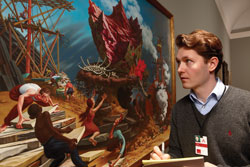It's Google, but is it art? Museums wonder whether they should open their galleries to digitizing

Troy Klyber, IP manager for the Art Institute of Chicago, sees participation in Google’s Art Project as a means to further its public mission. Photo by Saverio Truglia.
Google’s mission to digitize artwork from around the world is testing the bounds of copyright protection and the fairness of licensing contracts.
Launched in February 2011, the Google Art Project provides access to more than 30,000 high-resolution images of paintings, sculptures and photographs from more than 180 museums and institutions in 40 countries, including the Metropolitan Museum of Art in New York City, the Uffizi Gallery in Florence, the de Young Museum in San Francisco and the Van Gogh Museum in Amsterdam.
With the ability to zoom in to see precision details up close, the Google Art Project was designed to make artwork more widely available and to promote popular interest. But museums, while appreciating the attention, are wary about which art they share. And their lawyers are treading carefully.
Troy Klyber, intellectual property manager at the Art Institute of Chicago, saw participating in the Google Art Project as a way to fulfill the museum’s mission, which is to share its works with the public. But because ownership of an art object doesn’t necessarily include ownership of the object’s copyright, the Art Institute could only include works for which it had been assigned the copyright through gift or contract, or works by artists dead for more than 70 years. As a result, the Google Art Project features fewer examples of modern and contemporary art.
“Our selection was designed to avoid disputes,” Klyber says of the works included in the project. After analyzing the copyright status of its collections, the Art Institute sought copyright permissions from certain contemporary and modern artists and their estates. Some granted permission, but others feared commercial interests misusing high-quality images online.
“We ended up with a pretty good assortment of works that represent the collection,” Klyber says.
UNSETTLED MATTER
The museums are also aware of legal action against Google. The Authors Guild and the Association of American Publishers filed a class action in 2005 alleging copyright infringement against its Books Library Project, which provides access to the full text of books and magazines that Google scanned and converted to text using optical character recognition. The parties reached a $125 million settlement in 2008, but court approval of the settlement with the authors is still pending.
While no similar suits have been filed related to the Google Art Project, some nevertheless claim that high-resolution reproductions of online artwork can be exploited for unauthorized commercial gain. And when it comes to observing copyright licenses, Google places that burden on the participating museums.
“If you get a room full of museum professionals, you’d have a very nice distribution of opinion” on Google, says Joe Brennan, general counsel of the Field Museum of Natural History in Chicago. “Some think it’s a giant waste of time and fundamentally missing the point of a museum, asking: ‘Why would you share sacred objects and not charge for it?’ Others see it as the greatest thing since sliced bread.”
The Field, like most natural history museums, hasn’t been approached by Google to participate in the project. “My personal answer is that it’s an initiative that will lead to increased visitorship,” says Brennan. “It’s a rising tide that will lift all boats.”
Protecting the Art Institute’s nonpermissioned works was labor-intensive, particularly when it came to the project’s “museum view,” in which cameras panned full galleries. In those cases, nonpermissioned artworks had to be blurred. “It was someone’s job to go through and blur the other works from every angle. In all, we had more than 6,000 blurs,” Klyber says.
It’s too soon to say whether there have been more or fewer visitors to the Art Institute because of its participation in the Google Art Project, Klyber says. But “our decision to participate wasn’t driven by that expectation, but because it’s new and interesting,” he adds.
Yet despite the project’s novelty, Klyber says there hasn’t been much talk about it among his colleagues at other museums because of Google’s strictly enforced confidentiality agreement. When asked about the terms of the Art Institute’s contract with the Internet search giant, he diplomatically replies, “They are a large company and they are aware of their bargaining power.”
Not everyone is enamored of the Google Art Project. “Google is so proprietary about their licensing arrangements with public institutions, and it requires every museum to enter into a confidential agreement,” says Alexandra Darraby, founder of the Art Law Firm in Los Angeles and author of the Legal Guide to Digital Art & New Media, scheduled to be published this year by the ABA.
Because museums hold artworks in the public trust, licensing those assets requires transparency, Darraby says. “What are the obligations of a public institution to fulfill its public mission? I’m not sure some of these institutions are getting the legal advice they should,” she says.
“Is it Google? The museum’s own website? I don’t know what carrot Google holds in front of the museums” to secure their participation, she says. In particular, Darraby fears that Google may be capitalizing on its market position and corporate insularity. “It’s usually never right that one monolithic entity is acquiring all material,” adds Darraby, who is chair of the International Law Division of the ABA’s Forum Committee on Entertainment and Sports Industries.
Intellectual property audits are essential before a museum joins the Google Art Project, she insists, because often there are surprises regarding what copyrights a museum assumes it owns versus what it actually owns. “The digital world has great attractions and everyone thinks technology always moves us forward to a better place. But not always,” Darraby says. “It has many merits, but it doesn’t mean a wholesale licensing agreement with Google is the model to use.” For its part, Google declined to be interviewed for this story.
RISKS AND REWARDS
According to Adrienne Fields, associate counsel of the Artists Rights Society—which represents the IP rights of more than 50,000 artists and artists’ estates, including those of Picasso, Matisse and Rothko—Google has also been unwilling to enter into a working agreement with the ARS on behalf of its members. Instead, Google has placed the administrative and financial burdens on individual museums, requiring them to obtain rights from the ARS.
In addition, the project’s license terms are ambiguous, Fields notes. “Even in its early stages, the Google Art Project allowed users to share images and send them around to profit-generating websites such as Facebook.” This is particularly troublesome because the high-resolution images are of printable quality and could potentially be repurposed. “Museums have provided [the Artists Rights Society] excerpts of Google’s license terms and have questioned whether they could fulfill the expansive requirements without incident.”
A PARTIAL STEP
Yet the Field Museum’s Brennan notes that it’s very expensive to host giant-resolution images and, as a result, it’s fair for Google not to expose itself to copyright liability. “Museum professionals are very sophisticated people, and museums are extremely complicated businesses to run,” he says. “Some will choose not to participate, but I don’t see a risk in contracting with Google.”
With a collection of archeological objects dating back 2,000 years, copyright wouldn’t be Brennan’s challenge if it joined the project. Yet while the Field Museum’s mission is to “engage people to think about the deep past and evolution,” it’s still careful about the licensing implications of putting high-resolution images online. For example, it’s home to one of the world’s most iconic fossils, a Tyrannosaurus rex named Sue, which the Field Museum protects “very, very carefully.” Plus, he says, “too much free and easy exposure cheapens the impact.”
Still, Brennan’s team at the Field Museum is building a collection of three-dimensional images—what he describes as a partial step toward the Google Art Project paradigm. “When we have those built, we’ll be very interested in talking to Google.”
Write a letter to the editor, share a story tip or update, or report an error.


